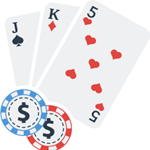Updated on: January 6th, 2025
Baccarat, often associated with high rollers and luxury, presents an intriguing combination of simple rules and exhilarating play for both beginners and veterans. At its core, your goal in Baccarat is to stake your bet on the hand that nears a total of nine.
Place your bets on your own hand, the banker's, or opt for a tie. Thanks to its streamlined rules and energetic pace, Baccarat is a staple favorite in gambling havens across the globe. Whether you're just starting or a casino aficionado, the game promises a dynamic and engaging journey.
Best Baccarat casino in Australia
Min Deposit: $10
Min Deposit: $20
Min Deposit: $20
Min Deposit: $30
How to play Baccarat: Basic Rules
To truly relish Baccarat, grasping its core rules is key. This beloved card game offers excitement for all sorts of players. By becoming familiar with its dynamics and wagering options, you'll be prepared for an enjoyable experience. Here's a guide to the rules of Baccarat.
Objective
In the enticing realm of Baccarat, your objective is straightforward: wager on the hand that approaches a sum closest to nine. Players have the flexibility to bet on their hand, the banker's hand, or the possibility of a tie. Victory is claimed by the hand nearest to nine.
Gameplay
- The essence of the game lies in wagering on the Player, the Banker, or a Tie, all before the cards are dealt.
- After the bets are placed, the dealer distributes a pair of cards to both the contestant and the Banker.
- · Participants tally the card values to determine who comes closest to achieving a total of 9.
- Depending on particular rules, additional cards might be drawn.
- Whichever side nears 9 the most emerges victorious in the session.
Role of the Banker and the Player
- Participants can stake their bets on either the Banker or the Player to claim the win.
- The Banker aims for a higher card total than the participant.
- On the contrary, the Banker works to outdo the Player’s total.
Scoring
Should a hand's total surpass 9, the score derives from the final digit in its sum.
For illustration, a hand bearing a 7 and 8 totals to 5 after removing the tens digit (7+8=15, leaving 5).
Types of Bets
- Stake your wager on the Player’s hand for a win.
- Opt to place your bet on the Banker’s hand for victory.
- Place your bets predicting that both the Player’s and Banker’s hands will tie.
Card Dealing and Values
- Generally, Baccarat is played with a set of 6-8 card decks.
- Cards numbered 2 through 9 carry a point value identical to their face value.
- 10s and face cards have a value of 0.
- Aces have a value of 1 point.
- The dealer begins by giving out two cards each to the participant and the Banker.
Third Card Rule
- A two-card total of 8 or 9, dealt to either the Player or the Banker, is termed a “natural,” negating the need for additional cards.
- Should the Player hold a total of 5 or less, an extra card is dealt to them.
- If the Player chooses to stand, the Banker will take another card when having a total of 5 or less.
- A total of 2 or lower prompts an additional card draw for the Banker.
- For a banker total of 3, an additional card can be drawn unless the player's third card is an 8.
- At a banker total of 4, a card draw can happen if the player's third card is between 2 and 7.
- If the Banker shows a total of 5, drawing an extra card depends on whether the Player’s third card is between 4 and 7.
- With a Banker total at 6, an additional card can be drawn if the Player’s third card is 6 or 7.
 Payouts and Winning
Payouts and Winning
Betting and winning on the Player’s hand offers a payout equivalent to your stake. Similarly, a winning bet on the Banker gives the same return, subject to a small 5% casino commission. Winning a bet on a Tie can increase your stake by 8 to 9 times, subject to casino terms.
The house edge in Baccarat With a lower house advantage, especially concerning Banker bets, the casino retains just a sliver of the wagered sums, boosting Baccarat’s attractiveness among players.
Baccarat gaming Tips
Consider these insightful strategies when stepping into a game of Baccarat:
- Plan Your Spending: Evaluate your financial boundaries and adhere to them. This strategy ensures financial control and limits your risk of severe losses.
- Embrace the Odds: Acquaint yourself with the probabilities tied to diverse Baccarat bets. This informs and enhances your wagering approach.
- Sidestep the Tie Wager: Although the “Tie” bet’s potential returns are alluring, its high house edge makes it a less attractive choice.
- Banker Bets: A Safer Choice: Statistically, the “Banker” bet carries a lesser house advantage than its “Player” counterpart. While a commission applies, it emerges more beneficial in the long run.
- Smart Bankroll Strategy: Managing your funds adeptly is essential. Ensure your bet sizes complement your budget to extend your playtime.
- Stay Composed: The role of chance in Baccarat is undeniable, emphasizing the need to remain cool-headed during play. Avoid impulsive choices driven by in-the-moment emotions.
How to play Baccarat FAQs
Your mission is to wager on the hand aiming for a sum nearing 9.
Place your chips on the designated Player, Banker, or Tie zones on the table as your betting action.
Baccarat betting includes placing wagers on either the Player, Banker, or predicting a Tie.
The general procedure in Baccarat involves dealing two cards to both the participant and the Banker, with the hand nearing nine being declared the winner.
In Baccarat, the rules governing the third card dictate when it is drawn, based on the initial two-card totals of each hand.
Baccarat’s payouts vary: securing a win as the Player yields a typical 1:1 return, while snatching a Tie victory could result in an 8:1 or even 9:1 return.
Baccarat boasts a favorable house edge, particularly with Banker bets, positioning it as one of the more player-friendly options within casinos.












 Payouts and Winning
Payouts and Winning






